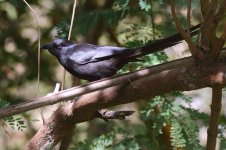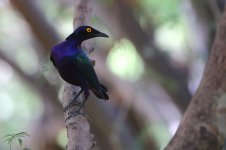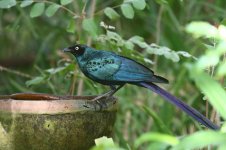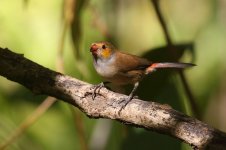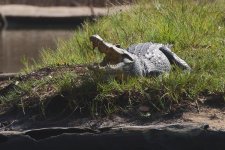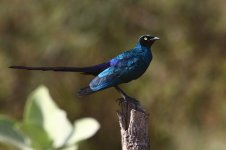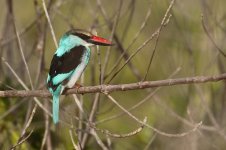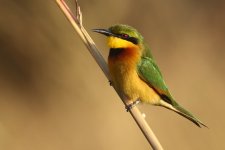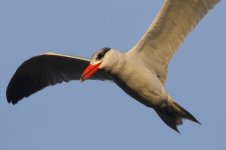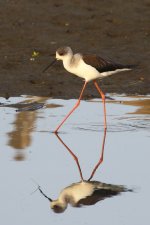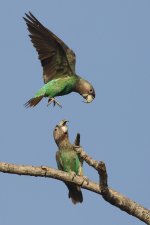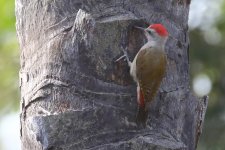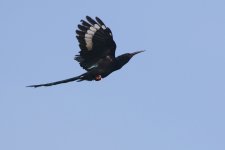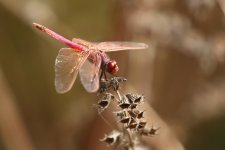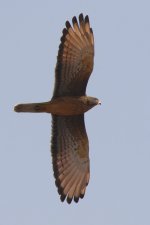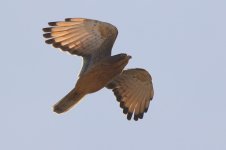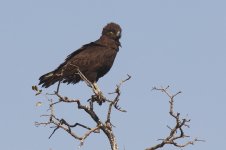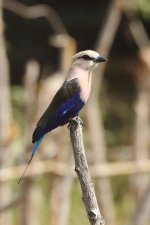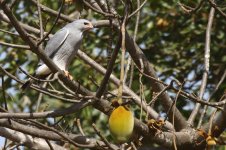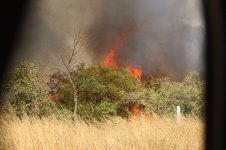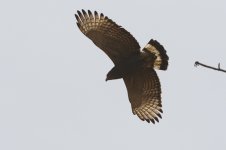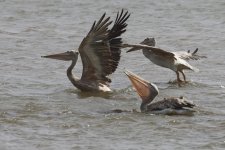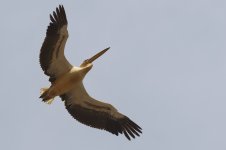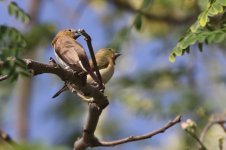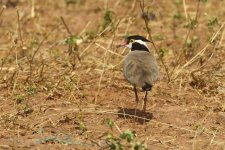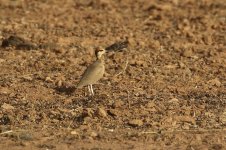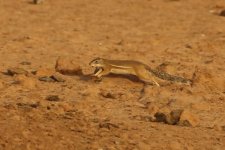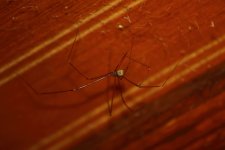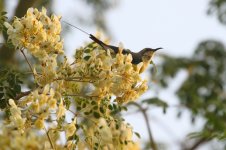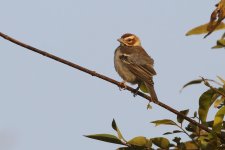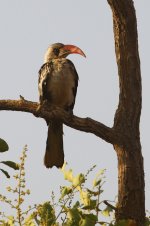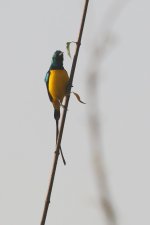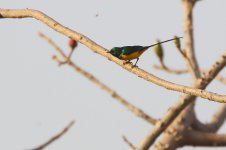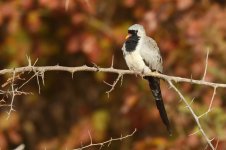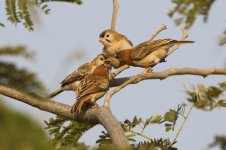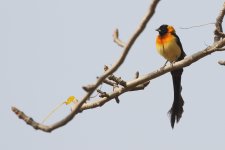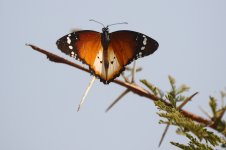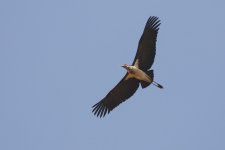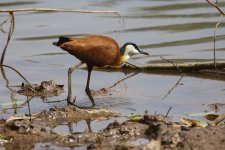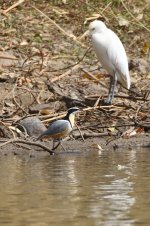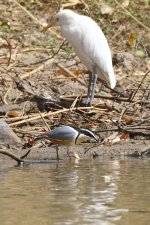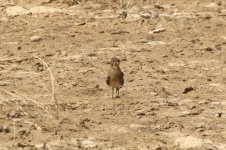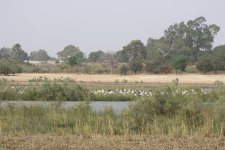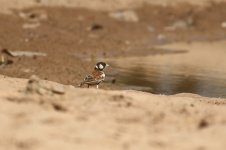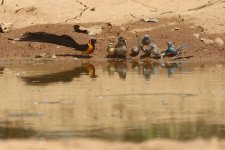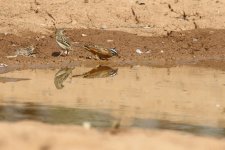Day 5: 11 January
Up as usual before dawn after a fairly comfortable night: it was cold though! Maybe it was cold relative to the heat of the days...
By daylight we were up and dressed and I was out hunting around for male Pygmy Sunbirds. Unfortunately the only one I found wasn't in plumage. Nothing else was really showing off - even a look from the observation tower in the corner of the compound produced nothing - so we attacked breakfast and were soon afterwards on our way, again starting somewhere near where we had been the previous evening. There was delight for Clare when the vehicle flushed a couple of Warthogs. The only real "safari mammal" of the trip, they trotted across fields, across the track, into the bushes, back on the track ahead of us - could I pick them up? No! Eventually I got a distant view of their backsides just before they disappeared. I mean, really, what hope is there if you can't spot a pig in the open?
Not long after that we stopped and had a short walk, which produced excellent views of Western Red-billed Hornbill (again, I know, but I don't see them in Farnborough!) and photo-opps with Namaqua Dove, Scarlet-chested Sunbird and Chestnut-crowned Sparrow Weaver. Ebrima was obviously looking for something else and he came up with it after a while: a family party of Speckle-fronted Weavers (tick) still feeding the juveniles, which enabled both individual portraits and group photos of the action.
After that it was back to the main road and we continued West along the North Bank, stopping to walk fields to look for bustards (no luck but a scuttling Double-spurred Francolin- marginally better view than the first one - Whinchat, Woodchat, Fan-tailed Warbler, a couple more Black-headed Lapwings and a Flappet Lark.
Returning to the bus we carried on but stopped for a full plumage male whydah that turned out to be Sahel Paradise Whydah and a tick as well as a ludicrous-looking spectacular bird. If I remember correctly Ebrima thought this was a bit early and the dry season must be biting hard further North to send them down already. Good for us birders - maybe not so good environmentally.
Just after that a roadside pool produced Gosling's Bunting, another split and therefore tick, but we hurried on to the next site because it was time for a biggie. Trouble is I'm not exactly sure where we were: judging from a subsequent report on Surfbirds it may have been Njow/Nja Kunda. We drove a little way up a dirt track and stopped not far from a shrinking pool edged with cattle-trampled mud: hurriedly climbing out we saw Wood and Green Sandpipers, a Jacana, Cattle Egrets, Spur-winged Plover - and, oh joy unconfined, a sleek elegant Egyptian Plover! An instant candidate for bird of the trip. It was bigger than I'd expected, somehow the proportions in photos and illustrations had left me imagining a chunky Ringed Plover-size bird but this was bigger than that and despite its lines and markings (I mean, this bird looks as if the colour scheme was designed by a top class car or aircraft company) there is a robustness about it. In between grilling it we added Little Swift and Red-rumped Swallow, plus a single Marabou spiralling high above. There was then a total cock-up when literally none of us heard Ebrima calling a Red-throated Bee-eater which would have been a tick. These things happen, it wasn't Ebrima's fault but our own.
We went for a short walk, finding a large (by normal standards) flock of Red-billed Quelea, our only Little Green Bee-eater of the trip and a Red-chested Swallow.
Around now he and Karanta got considerably distracted by youths hunting birds with a catapult. At the start of the season there had been eight Egyptian Plovers, on Ebrima's previous visit two, now one. Lemme see... Anyway in short order the catapult was confiscated and the youths ears considerably bent with a lecture on the law and economic realities of Gambia's situation. They went off and fetched their father on an ancient moped: he got the same lecture with the added spice of being told the penalty for killing protected birds was a ruinous fine and/or three months in jail, but claimed our heroes had stolen the catapult and he was fetching the cops. Guess what? that resulted in the same lecture including the economics of it (a second birding group had by now arrived to add weight to this argument): a small fee was paid for the catapult but it wasn't returned and Ebrima agreed to return and negotiate terms with the cops and village elders to enable the village to benefit financially from the visitors for the Egyptian Plovers. I guess this sounds more than a bit like bribery but the alternative is plain: indeed by Ebrima's next trip up there was a dip. Maybe it will be in place and working by next season (whenever that turns out to be....)
After this we were more than ready for the packed lunch of baguettes and salads that Ebrima produced at a stop by a roadside pool as we headed back East again. It was the same pool that we had seen Gosling's Bunting at earlier and, relaxing with food in the shade of bushes, we now got better views of them as well as another male Sahel Paradise Whydah and assorted small finches. By the time we left there our equilibrium was somewhere near normal.
John




